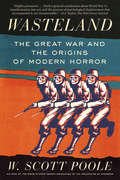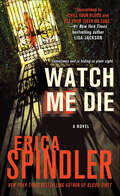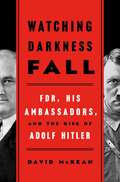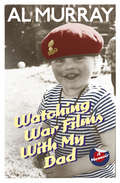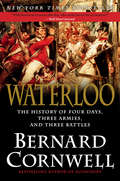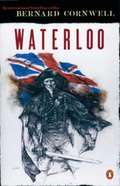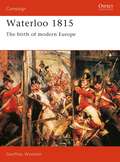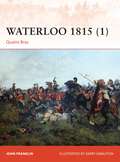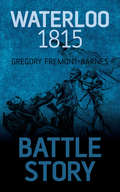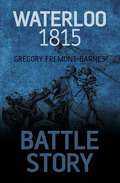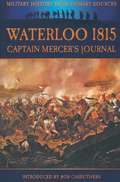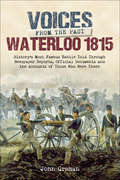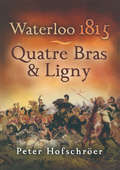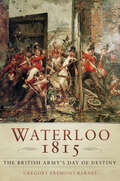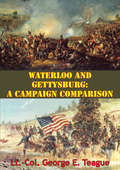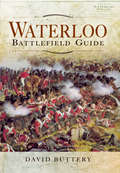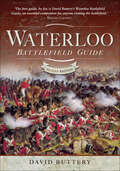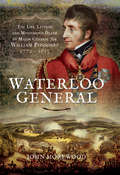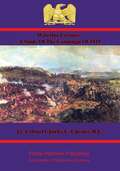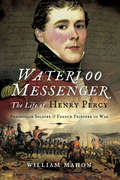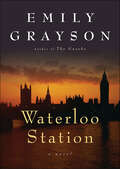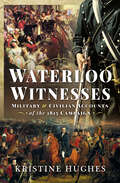- Table View
- List View
Wasteland: The Great War and the Origins of Modern Horror
by W. Scott PooleHistorian and Bram Stoker Award Nominee W. Scott Poole traces the confluence of military history, technology, and art that gave us modern horror films and literature.From Nosferatu to Frankenstein’s monster, from Fritz Lang to James Whale, the touchstones of horror can all trace their roots to the bloodshed of the First World War. Bram Stoker Award nominee W. Scott Poole traces the confluence of military history, technology, and art in the wake of World War I to show how overwhelming carnage gave birth to a wholly new art form: modern horror films and literature."Thoroughly engrossing cultural study . . . Poole persuasively argues that the birth of horror as a genre is rooted in the unprecedented destruction and carnage of WWI." —Publishers Weekly (starred review)
Watch Me Die: A Novel
by Erica SpindlerIn Spindler's thrilling new psychological drama, one woman's journey to recovery becomes her worst nightmare… Before Hurricane Katrina struck New Orleans, stained-glass restoration artist Mira Gallier had it all: a thriving business doing work she loved and an idyllic marriage to the perfect man. But the devastating storm stole her beloved husband – his body swept away by floodwaters, never to be found.Now, after years of pain and turmoil, it looks as if Mira is finally on the verge of peace and emotional stability. But her life, like the magnificent windows blown to bits by Hurricane Katrina, is about to be shattered once again. And this time, it's not a killer storm she faces, but a psychopath who will stop at nothing until he possesses her, body and soul…First, church windows that she restored are vandalized, and the priest who looked over them brutally murdered. Spray-painted across the glass are the words: He Will Come to Judge the Living and the Dead. Then, New Orleans is rocked by a terrifying chain of murders that all seem to be linked to Mira. The police, led by homicide detective Spencer Malone, are following a string of clues left by the killer on each victim – and beginning to wonder if the murderer isn't Mira Gallier herself.As Mira begins to unravel under pressure from all sides – and fear for her life – it's unclear whom she can trust. And when a man from her past appears out of nowhere, sparking something long forgotten in her heart, he quickly becomes the police's new prime suspect. One by one, the people in Mira's life are targeted, until it's clear that the killer has been saving her for last . . . and that there's nowhere left to run.
Watch Over Me: Code Talker Chronicles (Code Talker Chronicles #2)
by Eileen CharbonneauAt first, war widow Kitty Charente thinks she’s showing one of her boss’s salesman a day out on the town. But Luke Kayenta is undercover: he’s a Navajo code talker, and Nazi Agent Helmut Adler is hunting him in 1942 New York City. Isolationists are searching for Luke too. And his superiors at the the U.S. Office of Strategic Services want to know if he’s cracked under torture in Spain. Kitty and Luke must evade capture from one enemy and death from another as they race from the Lower East Side to the Savoy Ballroom to Coney Island, aided by unlikely allies in the Canadian and French spy networks, a Harlem baker, and even Weegee, New York City’s most famous tabloid photographer.
Watching Darkness Fall: FDR, His Ambassadors, and the Rise of Adolf Hitler
by David McKeanA gripping and groundbreaking account of how all but one of FDR's ambassadors in Europe misjudged Hitler and his intentionsAs German tanks rolled toward Paris in late May 1940, the U.S. Ambassador to France, William Bullitt, was determined to stay put, holed up in the Chateau St. Firmin in Chantilly, his country residence. Bullitt told the president that he would neither evacuate the embassy nor his chateau, an eighteenth Renaissance manse with a wine cellar of over 18,000 bottles, even though “we have only two revolvers in this entire mission with only forty bullets.”As German forces closed in on the French capital, Bullitt wrote the president, “In case I should get blown up before I see you again, I want you to know that it has been marvelous to work for you.” As the fighting raged in France, across the English Channel, Ambassador to Great Britain Joseph P. Kennedy wrote to his wife Rose, “The situation is more than critical. It means a terrible finish for the allies.”David McKean's Watching Darkness Fall will recount the rise of the Third Reich in Germany and the road to war from the perspective of four American diplomats in Europe who witnessed it firsthand: Joseph Kennedy, William Dodd, Breckinridge Long, and William Bullitt, who all served in key Western European capitals—London, Berlin, Rome, Paris, and Moscow—in the years prior to World War II. In many ways they were America’s first line of defense and they often communicated with the president directly, as Roosevelt's eyes and ears on the ground. Unfortunately, most of them underestimated the power and resolve of Adolf Hitler and Germany’s Third Reich.Watching Darkness Fall is a gripping new history of the years leading up to and the beginning of WWII in Europe told through the lives of five well-educated and mostly wealthy men all vying for the attention of the man in the Oval Office.
Watching War Films With My Dad
by Al MurrayAl Murray's (AKA The Pub Landlord) musing on his childhood where his fascination with history and all things war began.Have you ever watched a film with someone who, at the most dramatic scene, argues that the plane on screen hasn't been invented yet? Or that the tank rumbling towards the hero at the end of the film is the wrong tank altogether? Al Murray is that someone. Try as he might, he can’t help himself. Growing up in the 1970s, Al, with the help of his dad, became fascinated with the history of World War Two. They didn’t go to football; they went to battlefields. Because like so many of his generation whose childhood was all about Airfix, Action Man and Where Eagles Dare, he grew up in the cultural wake of the Second World War. Part memoir, part life obsession, this is Al Murray musing on what he knows best. And he’s sure to tell you things about history that you were never taught at school.
Water Resources Planning for the Upper Mississippi River and Illinois Waterway
by National Research Council of the National AcademiesThe U.S. Army Corps of Engineers recently completed its feasibility study for the Upper Mississippi River-Ilinois Waterway, which was one of the agency's longest and most complicated studies in its history. The first two reports from this WSTB committee reviewed analytical aspects of the Corps feasibility study. This report considered the broader issue of managing the multiple resources of the Upper Mississippi River and Illinois Waterway, especially with regard to several, recently-issued NRC reports on Corps of Engineers planning procedures. The report finds that a key issue regarding planning decisions on these river systems is the ambiguity related to several different pieces of legislation and acts that govern river management, and thus recommends that the administration and Congress clarify the federal intent for managing this river and waterway system. The report recommends an independent, retrospective reivew of the experience with a federal inter-agency Principals Group, which was convened to provide guidance to the Corps study. It is also recommended that the Corps strive to incorporate flexible, adaptive management principles through its entire water planning program, including operations of the lock and dam system.
Waterloo
by Bernard CornwellFrom the New York Times bestselling author comes the definitive, illustrated history of one of the greatest battles ever fought--a riveting nonfiction chronicle published to commemorate the two-hundreth anniversary of Napoleon's last stand.On June 18, 1815, the armies of France, Britain, and Prussia descended upon a quiet valley south of Brussels. In the previous three days, the French army had beaten the Prussians at Ligny and fought the British to a standstill at Quatre-Bras. The Allies were in retreat. The little village north of where they turned to fight the French army was called Waterloo. The blood-soaked battle to which the town gave its name would become a landmark in European history.In his first work of nonfiction, Bernard Cornwell combines his storytelling skills with a meticulously researched history to give a riveting chronicle of every dramatic moment--from Napoleon's daring escape from Elba to the smoke and gore of the three battlefields and their aftermath. Through quotes from the letters and diaries of Emperor Napoleon, the Duke of Wellington, and the ordinary officers and soldiers, Cornwell brings to life how it actually felt to fight those famous battles--as well as the moments of amazing bravery on both sides that left the outcome hanging in the balance until the bitter end.Published to coincide with the battle's bicentennial in 2015, Waterloo is a tense and gripping story of heroism and tragedy--and of the final battle that determined the fate of nineteenth-century Europe.
Waterloo
by Bernard CornwellJune 1815: The Duke of Wellington, the Prince of Orange, and Napoleon will meet on the battlefield--and decide the fate of EuropeWith the emperor Napoleon at its head, an enormous French army is marching toward Brussels. The British and their allies are also converging on Brussels--in preparation for a grand society ball. It is up to Richard Sharpe to convince the Prince of Orange, the inexperienced commander of Wellington's Dutch troops, to act before it is too late. But Sharpe's warning cannot stop the tide of battle, and the British suffer heavy losses on the road to Waterloo.Wellington has few reserves of men and ammunition; the Prussian army has not arrived; and the French advance wields tremendous firepower and determination. Victory seems impossible.
Waterloo 1815
by Geoff WoottenOsprey's study of the most famous battle of the Napoleonic Wars (1799-1815). Waterloo holds a special place among the great battles of history. The climax of more than twenty years of war, it was indeed a close-run affair, matching two of the world's greatest generals - Napoleon and Wellington. This volume covers the entire campaign including the battles of Quatre Bras, Ligny and Wavre, with five full-colour maps and three highly detailed bird's eye views showing decisive moments in the action. An excellent sense of the closeness of the battle is communicated - Wellington himself claimed it was "the nearest thing you ever saw in your life" - and this gripping account shows the full justice of that statement.
Waterloo 1815
by Gerry Embleton John FranklinTo coincide with the 2015 bicentennial of the Battle of Waterloo, Osprey publishes Waterloo 1815, a definitive three volume history of the historic battle. Based on new research drawn from unpublished first-hand accounts and illustrations, Waterloo 1815 provides a detailed resource for all aspects of the famous battle.This first volume of the trilogy, Quatre Bras, focuses on the lead-up to Waterloo itself. Two days before the main battle, an initial 8,000 Allied troops faced the 48,000 men of the French Armée du Nord under Marshal Ney at the strategically vital crossroads of Quatre Bras. Having been tricked by Napolean who was trying to drive a wedge between the Prussians and the Anglo-allied army, Wellington concentrated his troops at Quatre Bras, hoping to link up with the Prussians. There Wellington just managed to hold off Ney's attacks. The battle ended in a tactical stalemate but, because he was unable to join with Blücher's Prussians, Wellington retreated back along the road to Brussels to new positions at a small Belgian village called Waterloo, and thus set the stage for one of the greatest battles of all time.With detailed maps, illustrations and battlefield dispositions, Quatre Bras will lay the groundwork for any student of the Battle of Waterloo.
Waterloo 1815
by Gregory Fremont-BarnesThe Battle of Waterloo is one of the most important moments in military history. The might of the French Empire under the leadership of the Emperor Napoleon faced the Coalition army under Duke of Wellington and Gerhard von Blucher for one last time at Waterloo. The battle saw the culmination of a long campaign to destroy Napoleon’s forces and halt the growth of the French Empire. Both sides fought bitterly, and Wellington later remarked that “it was the nearest-run thing you ever saw in your life.” Both armies lost over 20,000 men on the battlefield that day, but it was the coalition that emerged victorious in the end. Wellington’s army counter-attacked and threw the French troops into disarray as the fled from the field. The coalition forces entered France and restored Louis XVIII to the throne. Napoleon was exiled to the island of Saint Helena, where he later died. Waterloo was a resounding victory for the British Army and changed the course of European history. This Battle Story tells you everything you need to know about this critical battle.
Waterloo 1815: Battle Story
by Gregory Fremont-BarnesOne of the most decisive battles in military history, Waterloo saw the culmination of a generation of war to bring a definitive end to French hegemony and imperial ambitions in Europe. Both sides fought bitterly and Wellington later remarked that ‘it was the nearest-run thing you ever saw in your life’.In this bloody engagement, more than 20,000 men were lost on the battlefield that day by each side, but it was the Anglo-Allies who emerged victorious. Their forces entered France and restored Louis XVIII to the throne, while Napoleon was exiled to the island of Saint Helena, where he later died.Waterloo was a resounding victory for the British Army and Allied forces, and it changed the course of European history. In this concise yet detailed account, historian Gregory Fremont-Barnes tells you everything you need to know about this critical battle.
Waterloo 1815: Captain Mercers Journal (Military History from Primary Sources)
by Bob CarruthersMore has probably been written about the Waterloo campaign than almost any other in history. It was the climax of the Napoleonic Wars and forms a watershed in both European and world history. However, the lethal combination of national bias, wilful distortion and simple error has unfortunately led to the constantly regurgitated traditional 'accepted' version being significantly wrong regarding many episodes in the campaign. Oft-repeated claims have morphed into established fact and, with the bicentenary of this famous battle soon to be commemorated, it is high time that these are challenged and finally dismissed.Gareth Glover has spent a decade uncovering hundreds of previously unpublished eyewitness accounts of the battle and campaign, which have highlighted many of these myths and errors. In this ground-breaking history, based on extensive primary research of all the nations involved, he provides a very readable and beautifully balanced account of the entire campaign while challenging these distorted claims and myths, and he provides clear evidence to back his version of events. His thoughtful reassessment of this decisive episode in world history will be stimulating reading for those already familiar with the Napoleonic period and it will form a fascinating introduction for readers who are discovering this extraordinary event for the first time.
Waterloo 1815: History's Most Famous Battle Told Through Newspaper Reports, Official Documents and the Accounts of Those Who Were There (Voices from the Past)
by John GrehanFor more than twenty years Europe had been torn apart by war. Dynasties had crumbled, new states had been created and a generation had lost its young men. When it seemed that peace might at last settle across Europe, terrible news was received Napoleon had escaped from exile and was marching upon Paris. Europe braced itself once again for war. The allied nations agreed to combine against Napoleon and in May 1815 they began to mass on France's frontiers. The scene was set for the greatest battle the world had yet seen.Composed of more than 300 eyewitness accounts, official documents, parliamentary debates and newspaper reports, Voices from the Past tells the story of Napoleon's last battles as they were experienced and reported by the men and women involved. Heroic cavalry charges, devastating artillery bombardments, terrible injuries, heart-breaking encounters, and amusing anecdotes, written by aristocratic officers and humble privates alike, fill the pages of this ambitious publication. Many of these reports have not been reproduced for almost 200 years.
Waterloo 1815: Quatre Bras
by Peter HofschröerThe Battle of Waterloo marked the climax of four extraordinary months. Napoleon returned from exile, ousted the unpopular King Louis XVIII, and then turned to launch a pre-emptive strike against the Allied armies assembling in the United Netherlands. Here Napoleon met Wellington who had cobbled together an army with contingents from the British, the United Netherlands and the Prussians, firstly at Quatre Bras and then finally at Waterloo.This is the second book in the series to cover the battle following on from Hougoumont.
Waterloo 1815: The British Army's Day of Destiny
by Gregory Fremont-BarnesWriting to his mother the day after the fighting, Captain Thomas Wildman of the 7th Hussars described ‘a victory so splendid & important that you may search the annals of history in vain for its parallel’. Little wonder, for Waterloo was widely recognised – even in its immediate wake – as one of the most decisive battles in history: after more than twenty years of uninterrupted conflict, this single day’s encounter finally put paid to French aspirations for European hegemony. The culminating point of the French Revolutionary and Napoleonic Wars, Waterloo also witnessed levels of determination and bravery by both sides which far exceeded anything experienced by the veterans of Wellington’s recent campaigns in Spain and Portugal. Indeed, it was that unconquerable spirit which left over 50,000 men dead on the field of battle and tens of thousands of others wounded.This thoroughly researched and highly detailed account of one of history’s greatest human dramas looks first at the wider strategic picture before focusing on the tactical roles played by individual British units – all meticulously examined with the benefit of an extensive array of hitherto unexploited primary sources which reveal the battlefield experience of officers and soldiers as never before.Refusing simply to repeat the same unchallenged accounts and to commit the same errors of previous historians, this work relies exclusively on hundreds of first-hand accounts, by men of all ranks and from practically every British regiment and corps present on that fateful day, to provide a fresh and revised perspective on one of the most pivotal events of modern times.
Waterloo 1815: Wavre, Plancenoit And The Race To Paris
by Peter HofschröerThe acclaimed historian sheds new light on the Battle of Waterloo and the defeat of Napoleon with a focus on the Prussian Army&’s critical contribution. Histories of the Waterloo campaign that brought an end to the Napoleonic Wars generally concentrate on the battle between the armies of Napoleon Bonaparte and the Duke of Wellington, giving Field Marshal Blücher's Prussian forces only passing attention. But in this fascinating historical analysis of the conflict, Peter Hofschröer provides a full account of the Prussians and their critical but often neglected side of the battle. Hofschröer vividly recounts the grueling Prussian advance towards the battlefield and the ferocious and decisive fight that broke out when they arrived. At every stage, he allows the reader to follow in the footsteps of the Prussian soldiers as they struggled across the Belgian countryside on that fateful day in 1815.
Waterloo And Gettysburg: A Campaign Comparison
by Lieutenant-Colonel George E. TeagueIn June of 1815 Napoleon led French forces on an offensive campaign into Belgium against the Allied Anglo-Dutch and Prussian armies under Wellington and Blucher. During this campaign Napoleon and several of his marshals made serious errors that led to missed opportunities for victory and ultimately to defeat at Waterloo. Less than 50 years later Robert E. Lee led Confederate forces on an offensive campaign into Maryland and Pennsylvania against the Union Army under Hooker initially, then Meade. A meeting engagement near Gettysburg, Pennsylvania led to three days of fighting during which Lee and several of his generals made critical errors that allowed opportunities for victory to pass and ultimately led to decisive defeat.These campaigns were remarkably alike in a number of ways. This paper reviews the campaigns and discusses similarities in the strategic settings, campaign objectives, size and disposition of forces, battlefield terrain, tactics employed, and leadership of each army. In particular, the paper compares the performances of selected French and Confederate leaders and how they contributed to the defeat of their respective armies. These comparisons provide valuable lessons learned for the conduct of future military operations.
Waterloo Battlefield Guide
by David ButteryA British military historian offers an expert introduction to The Battle of Waterloo in this essential companion for battlefield visitors. In Belgium on June 18th, 1915, the Battle of Waterloo marked the climax of the Napoleonic Wars—and a major turning point in world history. The combined forces of the Duke of Wellington and Field Marshal von Blücher delivered a devastating defeat to Napoleon. Though the outcome would have a major influence on the shape of Europe for more than a century, the battle itself cannot be properly understood without a detailed study of the landscape in which it was fought. Using eyewitness accounts and an intimate knowledge of the terrain, historian David Buttery vividly reconstructs the events of Waterloo as he takes readers across the battleground as it exists today. He provides essential context for understanding pivotal episodes in combat, including the day-long struggle for the chateau at Hougoumont, the massive French infantry assaults, repeated cavalry charges, the fall of La Haye Sainte, the violent clashes in the village of Plancenoit, the repulse of the Imperial Guard and rout of the French army.
Waterloo Battlefield Guide: Battlefield Guide
by David ButteryMuch of the material available to readers in the English language interested in the exploits of the troops of Hanover, Brunswick and Nassau is in the form of dry official reports, which stick to the basic facts and avoid all sentimentality and emotion. However, unbeknown to virtually anyone in the English-speaking world interested in the more human aspects of these 'foreign' troops fighting alongside the British at Waterloo, there are a number of memoirs and sets of letters, which have been published in Germany over the last two centuries. Until now, these had never been translated into English and so have been inaccessible to the vast majority. This volume seeks to put this right and to bring to life the human story of these German troops their trials and tribulations, their sufferings and their emotions and to finally reveal their views on the battle which many entered with mixed emotions. Highlights include an account of the confusion in the final great advance at Waterloo; eyewitness recollections of the defense of La Haye Sainte; rare battle reports by the Duke of Wellington; and a fascinating series of letters explaining the whereabouts of a number of 'missing' Hanoverian regimental and staff surgeons and subsequent court martials.
Waterloo General: The Life, Letters and Mysterious Death of Major General Sir William Ponsonby, 1772–1815
by John MorewoodThe defeat of Napoleons French army by the combined forces of Wellington and Blcher at Waterloo on 18 June 1815 was a turning point in world history. This was the climax of the Napoleonic Wars, and the outcome had a major influence on the shape of Europe for the next century and beyond. The battle was a milestone, and it cannot be properly understood without a detailed, on-the-ground study of the landscape in which it was fought and that is the purpose of David Butterys new battlefield guide. In vivid detail, using eyewitness accounts and an intimate knowledge of the terrain, he reconstructs Waterloo and he takes the reader and the visitor across the battleground as it is today. He focuses on the pivotal episodes in the fighting the day-long struggle for the chateau at Hougoumont, the massive French infantry assaults, repeated cavalry charges, the fall of La Haye Sainte, the violent clashes in the village of Plancenoit, the repulse of the Imperial Guard and rout of the French army. This thoroughgoing, lucid, easy-to-follow guide will be a fascinating introduction for anyone who seeks to understand what happened on that momentous day, and it will be an essential companion for anyone who explores the battlefield in Belgium.
Waterloo Lectures: A Study Of The Campaign Of 1815
by Lt.-Colonel Charles C. Chesney R.E.This ebook is purpose built and is proof-read and re-type set from the original to provide an outstanding experience of reflowing text for an ebook reader. Waterloo Illustration Pack - 14 maps/battle plans, 18 portraits of the personalities engaged, 10 illustrations. The Waterloo campaign of 1815 was a turning point in world history. After 25 years of almost constant warfare that raged from India to Canada, from South America to the Caribbean, peace among the European powers was decided on a small strip of land in modern day Belgium. The momentous fruits of the campaign have led to the decisions and actions of the belligerents and their armies to be argued back and forth ever since. Colonel Chesney's work is amongst a handful of books that are considered to be "standard" as histories of the campaign that have been translated into French and German. It is fitting that the work of such a learned soldier, who is also a late professor of Military Art and History at the Staff College in Camberley, should be such a balanced and detailed account of the campaign. This ebook is based on the 4th edition which includes all of the changes that Colonel Chesney wished to be incorporated until his untimely death and was published posthumously. Title - Waterloo Lectures: A Study Of The Campaign Of 1815 (4th Edition) Author -- Lt.-Colonel Charles C. Chesney R.E. (1826-1876) Text taken, whole and complete, from the edition published in 1907, London, by Longmans, Green and Co. Original - xiv and 251 pages. Illustrations - The original map cannot be provided with this edition due to its A3 size - We have added our Waterloo Illustration pack to ensure that the reader can follow the text.
Waterloo Messenger: The Life of Henry Percy: Peninsular Soldier & French Prisoner of War
by William MahonAt the Battle of Waterloo Sir William Ponsonby, a man who the Duke of Wellington stated had rendered very brilliant and important services and was an ornament to his profession, was killed by French lancers after leading the Union Brigade (the three Dragoon Regiments of the Royals, Iniskillings and Scots Greys) in a charge that wrecked a French advance that threatened Wellington with defeat. Sir William was a career soldier who had led his regiment in the decisive charge at the Battle of Salamanca and served with great distinction during the Peninsular War. Yet historians have blamed him because the charge at Waterloo got out of hand. In this book John Morewood uses family sources, including Sir Williams letters, as well as French and German accounts, to restore his reputation and, by shedding new light on the battle, establishes what really happen to him on that fatal afternoon. It is also a biography of a man whose bravery and professionalism distinguished him as one of the outstanding cavalry commanders of the age.
Waterloo Station: A Novel
by Emily GraysonThese were days of uncertainty and peril, of noble deeds and great sacrifice.An exciting time to be young and adventurous . . . but a dangerous time to fall in love.
Waterloo Witnesses: Military and Civilian Accounts of the 1815 Campaign
by Kristine HughesThe events of Sunday, 18 June, stand as the defining moment of the year 1815, if not of an entire era. The allied victory over Napoleon’s French army at the Battle of Waterloo reshaped governments and boundaries, made or broke fortunes and touched thousands of lives in ways both large and small, and it has been analysed, dissected and refought on paper a hundred times. Perhaps, though, the very best words ever written about that momentous campaign are the first-person accounts recorded as events unfolded. It is these vivid accounts that Kristine Hughes has collected together in order to convey the hopes, fears and aspirations of their authors. They inject the story of the battle with a level of humanity that reclaims it from the realm of legend and restores it to the people who witnessed it. In chronological order her work pieces together a novel view of the battle and events surrounding it as they were experienced by both military men and civilians. The result is a fascinating and varied picture of the individuals involved and the society of the period. Their words make compelling reading.
